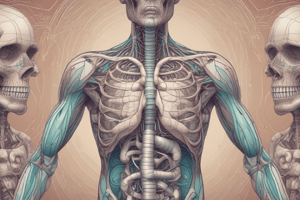Podcast
Questions and Answers
What is the primary function of the lungs?
What is the primary function of the lungs?
- To regulate body temperature
- To filter the blood
- To exchange oxygen and carbon dioxide through respiration (correct)
- To aid in digestion
What is the space between the two layers of the pleura called?
What is the space between the two layers of the pleura called?
- Bronchioles
- Pleural cavity (correct)
- Trachea
- Alveoli
What is the term for the maximum amount of air the lungs can hold?
What is the term for the maximum amount of air the lungs can hold?
- Functional residual capacity
- Residual volume
- Total lung capacity (correct)
- Vital capacity
What is the term for the airways that divide into smaller bronchioles?
What is the term for the airways that divide into smaller bronchioles?
What is the term for a condition characterized by inflammation and narrowing of the airways?
What is the term for a condition characterized by inflammation and narrowing of the airways?
What is the term for the amount of air remaining in the lungs after a normal exhalation?
What is the term for the amount of air remaining in the lungs after a normal exhalation?
What is the term for the small sacs where gas exchange occurs?
What is the term for the small sacs where gas exchange occurs?
What is the term for a progressive lung disease that makes it difficult to breathe?
What is the term for a progressive lung disease that makes it difficult to breathe?
Study Notes
Structure of the Lungs
- The lungs are a pair of organs located in the chest cavity
- Each lung is surrounded by a double-layered membrane called the pleura
- The outer layer is called the parietal pleura, and the inner layer is called the visceral pleura
- The space between the two layers is called the pleural cavity
Functions of the Lungs
- The primary function of the lungs is to exchange oxygen and carbon dioxide through the process of respiration
- The lungs take in oxygen through inhalation and release carbon dioxide through exhalation
- The lungs also filter the air we breathe, removing dust, bacteria, and other particles
- The lungs help to regulate pH levels in the body by removing excess hydrogen ions
Parts of the Lungs
- The trachea (windpipe) divides into two bronchi, one for each lung
- The bronchi further divide into smaller bronchioles, which eventually lead to the alveoli
- The alveoli are small sacs where gas exchange occurs
- The lungs also contain blood vessels, including the pulmonary arteries and veins
Lung Capacity
- The total lung capacity (TLC) is the maximum amount of air the lungs can hold
- The vital capacity (VC) is the maximum amount of air that can be exhaled after a maximum inhalation
- The functional residual capacity (FRC) is the amount of air remaining in the lungs after a normal exhalation
Lung Diseases and Disorders
- Chronic obstructive pulmonary disease (COPD) is a progressive lung disease that makes it difficult to breathe
- Asthma is a condition characterized by inflammation and narrowing of the airways
- Pneumonia is an infection of the lungs that can cause inflammation and fluid buildup
- Lung cancer is a type of cancer that affects the lungs and is often caused by smoking or exposure to carcinogens
Structure of the Lungs
- Lungs are a pair of organs located in the chest cavity, surrounded by a double-layered membrane called the pleura
- Pleura consists of two layers: parietal pleura (outer) and visceral pleura (inner), with a space between them called the pleural cavity
Functions of the Lungs
- Primary function is to exchange oxygen and carbon dioxide through respiration
- Lungs take in oxygen through inhalation and release carbon dioxide through exhalation
- They filter the air we breathe, removing dust, bacteria, and other particles
- Lungs help regulate pH levels in the body by removing excess hydrogen ions
Parts of the Lungs
- Trachea (windpipe) divides into two bronchi, one for each lung
- Bronchi further divide into smaller bronchioles, eventually leading to alveoli
- Alveoli are small sacs where gas exchange occurs
- Lungs contain blood vessels, including pulmonary arteries and veins
Lung Capacity
- Total lung capacity (TLC) is the maximum amount of air the lungs can hold
- Vital capacity (VC) is the maximum amount of air that can be exhaled after a maximum inhalation
- Functional residual capacity (FRC) is the amount of air remaining in the lungs after a normal exhalation
Lung Diseases and Disorders
- Chronic obstructive pulmonary disease (COPD) is a progressive lung disease that makes it difficult to breathe
- Asthma is characterized by inflammation and narrowing of the airways
- Pneumonia is an infection of the lungs that causes inflammation and fluid buildup
- Lung cancer is a type of cancer that affects the lungs, often caused by smoking or exposure to carcinogens
Studying That Suits You
Use AI to generate personalized quizzes and flashcards to suit your learning preferences.
Description
Learn about the structure of the lungs, including the pleura and pleural cavity, and their primary function in exchanging oxygen and carbon dioxide through respiration.




